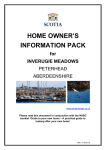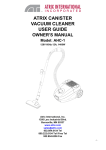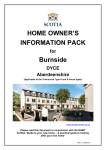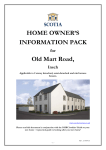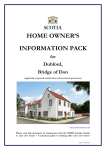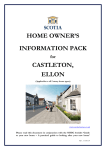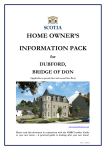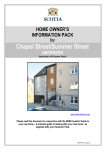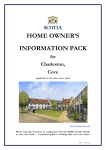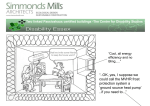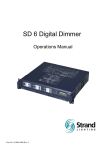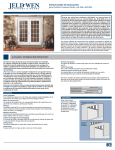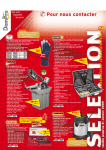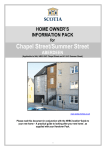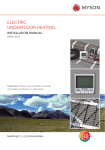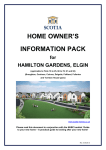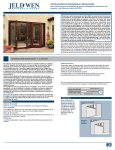Download File - Scotia Homes
Transcript
HOME OWNERS INFORMATION PACK for HAMILTON GARDENS ELGIN MORAY www.scotia-homes.co.uk Please read this document in conjunction with the NHBC booklet ‘Guide to your new home – A practical guide to looking after your new home’ Rev. 6 11.02.13 INDEX OPERATING INSTRUCTIONS FOR GAS-FIRED CENTRAL HEATING .. - 2 HOT WATER AND COLD WATER SYSTEMS .......................................... - 2 RADIATOR SAFETY PRECAUTIONS ....................................................... - 2 HEATING AND HOT WATER INSTALLATION ......................................... - 2 GAS SYSTEM ............................................................................................ - 2 HOT AND COLD WATER SERVICES ....................................................... - 2 KITCHENS.................................................................................................. - 2 EXTRACTOR FANS ................................................................................... - 2 WINDOW VENTILATION AND AVOIDING CONDENSATION .................. - 2 TELEVISION AERIAL INSTALLATION ..................................................... - 2 TELEPHONE INSTALLATION ................................................................... - 2 WINDOWS AND FRENCH DOORS ........................................................... - 2 OPERATING INSTRUCTIONS FOR THE .................................................. - 2 ELECTRICAL INSTALLATION .................................................................. - 2 SMOKE DETECTORS ................................................................................ - 2 EXTERNAL DOORS .................................................................................. - 2 INTERNAL DOORS.................................................................................... - 2 WALL TILING ............................................................................................. - 2 SHOWER WALL PANELLING ................................................................... - 2 FLOOR FINISHES ...................................................................................... - 2 ROOF SPACE ............................................................................................ - 2 CONSTRUCTION OF WALLS, PARTITIONS & CEILINGS ...................... - 2 FIXING PROBLEMS – IMPORTANT NOTICE ........................................... - 2 METERS ..................................................................................................... - 2 EXTERNAL AREAS ................................................................................... - 2 SCHEDULE OF TEST CERTIFICATES ..................................................... - 2 SCHEDULE OF MATERIALS .................................................................... - 2 - NOTE: The information contained in this document is for our Standard House Type and may not cover specific variations requested by you. -2- OPERATING INSTRUCTIONS FOR GAS-FIRED CENTRAL HEATING Introduction Your home has been fitted with a gas-fired heating system serving radiators and a domestic hot water supply. The gas-fired boiler is located in the garage, kitchen, utility or hall cupboard; you will find the operating and maintenance instructions for the boiler in your Handover Pack. If, after referring to the user information on boiler controls in the boiler instruction manual, you are unable to find the answers to any boiler problems then in the first instance please contact Scotia Homes. You are responsible for the annual maintenance and servicing of the boiler, this should be arranged through any reputable gas safe registered plumbing and heating contractor. Heating and Domestic Hot Water Controls The system has the following controls:1. Boiler isolating switch 2. Programmable Room Thermostat ( a remote sensor in hallway for control of heating). 3. Thermostatic radiator valves to radiators (except on the by pass radiator) 4. Frost Thermostat Boiler Isolating Switch This switch will be found on the wall next to the boiler in the garage, utility, kitchen or hall cupboard. This switch is to isolate the electrical supply to the boiler and should be left on at all times. And only use this switch if a fault develops on the boiler. Programmable Room Thermostat The programmable room thermostat is normally located in the utility room or kitchen. It controls the boiler, telling it when you require central heating and hot water. The programmer has the facility to give several on/off times. Temperatures can also be selected for each on/off time. When the heating is selected on the system it will operate until the set temperature is achieved. The temperature is measured in the hallway by the remote temperature sensor. When the system is selected off, the boiler will not operate unless the temperature in the hallway drops below the setback temperature selected. You can select your minimum desired house temperature, normally this can be set between 12 to 16° C. -3- Please refer to the manufacturers instructions in your handover pack for further instructions. Thermostatic Radiator Valves Thermostatic Radiator Valves are fitted for comfort control. i.e. 1 – low level heat, 5 – maximum level heat. Depending on level of comfort required 2 – 4 should be selected. Please refer to Manufacturer’s Instructions in your Handover Pack for full details. Frost thermostat (only fitted where boilers are located in garage) In severe weather conditions the frost thermostat can override the time clock and start up the heating system to prevent frost damage to the boiler and pipe work. Central Heating Should your central heating or hot water fail to work, please ensure that all of the procedures laid out in the boiler manufacturer's literature are followed. Failure to do this may result in a charge being made for an unnecessary call out. Bleeding of Radiators This should not be required with a sealed system. However, radiators feeling warm at the bottom and cold at the top would indicate air in the radiator. There are airing points normally at the top of the radiator. Use an air-bleeding key to turn clockwise to reduce air. You can do this by inserting the key and turning it anti-clockwise, then once the air stops a small amount of water will be discharged, quickly turn the key clockwise to tighten. Check pressure gauge on boiler, if it is below that recommended in the manufacturer's instructions, then it will be necessary to top up the system. See enclosed boiler user guide for full instructions. RADIATOR SAFETY PRECAUTIONS Users should ensure that those who may come into close proximity to hot radiators are aware of the risks of burns. Users should take any necessary steps to minimise the risks of burns from hot radiators (for example where there are very young children in the room). Where applicable, consideration should be given to placing guards in front of the radiators or reducing the temperature of individual radiators by turning the thermostatic radiator valve to a low setting. Radiators are heavy items and are securely fastened to the wall on installation, with appropriate fasteners to secure the radiator bracket and suit construction of the wall. Decorative covers (such as the decorative perforated MDF or timber covers that you can purchase from DIY stores) will significantly reduce the output of a radiator and thermostatic radiator valves should not be fitted inside these radiator covers (as this will stop the valves from working efficiently). These covers are not recommended as they will, by consequence, impede an individual room’s heat requirement, which your new heating system has been carefully designed to provide. The only exception to this would be the comments above regarding safety of young children. if you do need to fit a radiator cover for this purpose then you should use one of the metal mesh -4- type covers, similar to a fire place guard, which will not impede the flow of heat from your radiator into the room. Radiators should not normally be used for the mounting of clothes airers, cat beds or other such fixtures. The mounting brackets of the radiator are designed to support the weight of the radiator itself and water contents, allowing for an adequate safety margin, additional weight may compromise this margin and cause risk of failure, leaks and potential hot water burns. Appropriate facilities are required by Building Regulations for internal and/or external drying facilities and these are provided (please see “Ventilation and avoiding condensation”). Radiator-mounted airers and other devices may lead to excessive internal moisture and any chips/damage caused to the radiator itself may compromise the protective coating and potentially lead to corrosion/failure, which may not be covered by warranties. HEATING AND HOT WATER INSTALLATION Heating and hot water are provided by an ALPHA FLOW SMART SYSTEM 25 or 50 which comprises a condensing Combination Boiler, with a gas saver flue gas heat recovery unit together with either a 25 or 50 litre thermal store. A full explanation of how the system operates is included in the installation and servicing instructions and the operation of the boiler is also fully explained in the enclosed boiler user instructions. A copy of the User manual, installation & service instructions, inspection, commissioning and service record logbooks for the system are enclosed with your handover pack. An annual gas service of the boiler and inspection/maintenance of the associated equipment, in accordance with the above instructions, is required to be carried out by gas safe registered personnel. Failure to carry this out will invalidate the manufacturers and NHBC warranty. GAS SYSTEM Never obstruct gas boiler flue outlets or ventilation if provided to the boiler. Never tamper with the gas installation or equipment. Any alterations to the gas supply pipework or work in construction with any gas appliance should only be carried out by gas safe registered personnel. If you suspect a gas leak: 1. Extinguish all naked flames. 2. Turn off the gas at the meter. 3. Open all doors and windows. 4. Call the gas company on its emergency number which is in the phone book under ‘GAS’. There is no call-out charge. -5- HOT AND COLD WATER SERVICES Mains Cold Water Service The stopcock for the incoming cold water service is located under the Utility or Kitchen sink. There is a single mains incoming water service with a stopcock, which is located in the boundary box in the footpath. Domestic Hot Water The Alpha Flow Smart system produces domestic hot water in an energy efficient manner and the operation of this is fully explained in the enclosed Instruction Manuals. External Water Tap (if fitted) Where there is a risk of severe frost, water supply to tap should be isolated and pipe work drained and the tap should be left in the open position. Sanitary Ware/Taps Sanitaryware should be cleaned in accordance with the manufacturer's instructions which are enclosed in your Handover Pack. Thermostatic mixing valve A thermostatic mixing valve to limit the hot water temperature at the bath tap to a maximum of 46°C is fitted below the bath. It is recommended that initial temperature checks are carried out six weeks after occupation of the property, and then an annual check is to be carried out to test the water temperature to ensure the maximum limit of 46°C is not exceeded. KITCHENS Kitchen Appliances, Sink Units and Worktops Refer to the manufacturer’s instructions for operating and cleaning of kitchen appliances, sinks, units and worktops which are enclosed in your Handover Pack. Connecting Appliances – (where applicable) When fitting a dishwasher or washing machine, please ensure the blanked end of the waste pipe tee piece has been removed and that the water suppliers and wastes are securely connected to the pipe work. Bathroom and En-Suite Fan EXTRACTOR FANS Control switches are located adjacent to light switches. Fans should be switched on to remove moisture and odour. -6- Manufacturer’s installation and maintenance information is enclosed within your Handover Pack. A humidity controlled fan may be fitted in some houses which complies with amended regulations for provision of clothes drying spaces, generally in bathrooms. This fan will automatically operate when there is excess moisture in the air (high humidity) and will switch off when the moisture content of the air is reduced to the normal level (set humidity point). For the avoidance of any doubt, the isolator switch for a humidity controlled fan should be left in the ‘on’ position, failure to do so, where clothes are dried in this area, may result in the build-up of condensation and/or mould, and may affect your warranties with the NHBC and Scotia. At the time of writing, this is applicable to plot 392 and other plots completed from January 2013. WINDOW VENTILATION AND AVOIDING CONDENSATION Most windows are fitted with ‘trickle’ ventilators. These can be opened and closed to allow more or less ventilation. Condensation will be a problem in all new houses if adequate background heating and ventilation is not used, we would suggest that you read carefully the section within the NHBC booklet: GUIDE TO YOUR NEW HOME, preventing condensation on pages 6 and 7. The following are general guidelines for your information. To deal with condensation, take these two steps: Produce less moisture Ordinary daily activities produce a lot of moisture very quickly. Cooking: To reduce the amount of moisture in the kitchen, cover pans and do not leave kettles boiling, use your cooker hood extractor fan. Washing clothes: Put washing outdoors to dry if you can. Or put in the bathroom with the door closed and the window open or fan on. If you have a tumble dryer, ventilate it to the outside (unless it is the self-condensing type). DIY kits are available for this. Ventilate to remove moisture You can ventilate your home without making draughts. Some ventilation is required to expel the moisture, which is produced all the time, mostly just by people’s breath. Keep a small window ajar or a trickle ventilator open when someone is in the room. You need much more ventilation in the kitchen and bathroom during cooking, washing up, bathing and drying clothes. This means using the installed fan or opening windows wider. -7- Close the kitchen and bathroom doors when these rooms are in use. This helps prevent the moisture reaching other rooms, especially bedrooms, which are often colder and more likely to get condensation. TELEVISION AERIAL INSTALLATION A television aerial socket has been provided within the Lounge, the cable has been left coiled in the loft for you to supply and fit an aerial. TELEPHONE INSTALLATION Telephone points are installed as show on the sales drawings and are all wired back to the master point which is located on the external lounge wall. It is your responsibility to arrange the final connection to the master point by your chosen telephone service provider. WINDOWS AND FRENCH DOORS Your home is fitted with lockable window handles to all ground floor windows and standard (non-locking) handles to all first floor windows. A key is supplied to operate the ‘lockable’ handles and care should be taken to prevent damage to the handle by trying to force open when lock is engaged. All hinges, locks and other moving parts such as shoot bolts and cams should be lubricated on a regular basis. Glass may be cleaned with either a proprietary household glass cleaner (following the manufacturer’s instructions) or solution of soapy water. Glass can be easily scratched therefore ensure heavy grime or dirt is removed carefully using soapy water. PVCu frames should be cleaned every 3/4 months with soap and water. A non abrasive proprietary cleaner suitable for plastic may be used for more stubborn blemishes following the manufacturer’s instructions. Avoid using solvent based or abrasive cleaners as these will damage the PVC frames or glass. Notes regarding glass coatings: To comply with current building regulations all double glazed units installed in your home will have a low emissivity coating. Low emissivity (Low-e) glazing is a vital component of an energy efficient window or French door. It has a surface coating that allows short wavelength heat from the winter sun to enter your home through the glazing, while reflecting back into the room the long wavelength heating produced by your heating system. This reduces heating costs and minimises internal condensation. Please note that this Low-e coating has considerable advantages but you should be aware that there are some minor features, due to the coating of the glass, which you can see in some or all of the following ways; -8- • As a tint in the glass • As a ‘haze’ when viewing through the glass at some angles and in some lighting conditions • By the appearance of condensation on the outside of the glass under certain weather conditions (which is positive proof that the glass is preventing heat loss from your house) • There may be minor blemishes visible arising from the coating process and the tint may also change between individual double glazed units if the units are made from different batches of glass. These are not detrimental to the functioning of the unit and are not a defect. Please note that if you are replacing any of your double glazed units in the future you should ensure that your glazier uses low emissivity glass in your windows. Note regarding glass specifications: In addition to the note regarding Low-e coatings above, you should also be aware that certain windows may have either laminated or toughened safety glass installed. Any future replacement glazing units should be to the same specifications as originally fitted. Any competent glazier will be able to identify the glazing specification used and you should ensure that lower specifications are not used. OPERATING INSTRUCTIONS FOR THE ELECTRICAL INSTALLATION CONSUMER UNIT The Consumer Control unit for your property is located in the garage or hallway cupboard; it contains labelled circuit breakers for each circuit in the property. This is a device that controls the electricity supply to your home, splitting the incoming electric supply into various electrical circuits around your home. The consumer control unit contains Main Switch, RC BO (Residential Current Operated Circuit Breaker) RCD (Residual Current Device) and MCB’s (Miniature Circuit Breakers). The main switch is normally ‘ON’ to isolate all supplies switch to ‘OFF’. There are two RCD’s in your consumer unit. Each RCD protects a section of the consumer unit. They are designed to trip when there is an electrical leakage to earth thereby giving protection to personnel. An RCD would normally trip before an MCB. These ‘Circuit Breakers’ are all designed to ‘trip’ if there is a fault in a circuit or if a faulty appliance is switched on. This helps to prevent serious accidents that may result in damage and injury. Under fault conditions these will be in the ‘tripped position’. The following items can cause the RCD to trip – 1. “Blown” light bulbs. -9- 2. Faulty plug-in appliances such as kettle, iron etc 3. A faulty fixed appliance such as fridge, freezer etc. To reset, and for testing regime, follow the manufacturer’s instructions contained in your Handover Pack. It is important to ensure that the bulbs used in light fittings do not exceed the rating for that fitting. Electricity is dangerous and can kill. If you are in doubt about anything concerning electrical items, you should always consult a qualified electrical contractor. SMOKE DETECTORS Your house is fitted with a smoke detector usually in the hallway/landing. They are mains operated with battery back up and connected to bedroom lighting circuits. They are extremely sensitive to smoke and dust particles of any kind. If the detector is activated you should check the property and if no reason is found, it could be a nuisance alarm caused by cooking smoke or something similar. If this occurs, open a window to clear the smoke or dust and the alarm will cease. To reset or to test the smoke detectors, follow the manufacturer’s instruction as enclosed in your Handover Pack. The battery should be changed as recommended by the manufacturer, an intermittent beep normally indicates battery needs to be replaced. EXTERNAL DOORS All ironmongery should be cleaned on a regular basis using warm soapy water. Do not use abrasive or corrosive material to clean the ironmongery as this will damage the finish to handles, letter plate, eye viewer, chain and rain deflectors. Glazing can be cleaned with warm soapy water, avoid using anything which may scratch the glass. The multi-point locking system should be lubricated with WD40, or a similar product, on a regular basis to ensure the smooth operation capabilities of the cylinder, handle and the locking mechanism. The weather sill at the base of the door should be kept clear of debris to allow the drainage holes to function. The rubber gaskets in the sill and door frame should also be checked periodically for damage and replaced as required. INTERNAL DOORS - 10 - Handles should be cleaned with a soft non abrasive cloth and for stubborn stains mild soapy water may be used. Care should be taken to avoid scratching surface of handles. The mechanism of the handle should be lubricated once a year with a light oil. Hinges and latches / locks should be lubricated on a regular basis with WD40 or similar product. WALL TILING Wall Tiles and in particular the grout between tiles should be regularly cleaned using a proprietary tile / grout cleaner in accordance with the manufacturers instruction. Grout should be inspected and any areas which become loose should be replaced. The sealant between the wall tiling and any worktops should be inspected and replaced as necessary. SHOWER WALL PANELLING Laminate wall panelling should be cleaned by using hot water and a mild detergent applied with soft cloths or soft nylon brush. Non scratch cleaners may also be used. On no account should scouring pads, acid based toilet cleaners or limescale cleaners be used. Wall panelling and shower enclosure / tray should be dried off after use. Abrasive or aggressive cleaning products should not be used as they will damage the laminate surface of the panel. The sealant around the base of the wall panel should be inspected and replaced as necessary to prevent water ingress between the shower tray and the panelling. FLOOR FINISHES Any wooden flooring laid at the time of entry will not be lifted and re-laid as a result of any maintenance work requiring to be done. Before laying vinyl or wooden overlay flooring to concrete or screeded floors the moisture content should be checked, as it can affect the flooring, and, if required, treated in accordance with the flooring suppliers recommendations. A self levelling screed should also be applied, in accordance with its manufacturer’s instructions to concrete or screeded floors prior to laying any vinyl or overlay type floorings all in accordance with your flooring suppliers recommendations. Chipboard flooring should be prepared in accordance with manufacturer’s recommendations prior to laying of vinyls, wooden overlays or ceramic floor tiles. ROOF SPACE - 11 - The attic space has not been designed to allow for storage. Do not use the attic space for storage. Flooring the roof space and use of the attic for storage may cause deflection in the roof structure. The attic has mineral wool insulation between and over ceiling joists. This insulation can cause skin irritation. If handling the insulation it is recommended that protective clothing be worn. Care should also be taken if entering the attic – the ceiling plasterboard between the joists will not support your weight. It is advised that you do not enter the attic space. CONSTRUCTION OF WALLS, PARTITIONS & CEILINGS All External Walls: 100mm thick blockwork outer leaf with roughcast finish. 50mm wide cavity and inner leaf of 100mm thick blockwork, rigid slab insulation, metal framing and plasterboard lining to inside of inner leaf. It is not uncommon for some internal walls to be loadbearing, so do not remove or alter them - or make substantial alterations to them - without getting professional advice. Note that all external walls are likely to be loadbearing and must not be altered without professional advice. You should also check relevant Local Authority permissions and/or use the services of a qualified architect before considering either of the above. All Partitions: 70mm metal studwork partitions with plasterboard finish each side. Ceilings: Plasterboard fixed to underside of floor joists or to underside of roof trusses. Appropriate proprietary fixings should always be used to suit the wall construction. FIXING PROBLEMS – IMPORTANT NOTICE Fixings should never be made to the following wall areas:a) Directly above or below any electrical socket outlet, switch or appliance. b) Directly horizontal to any electrical socket outlet, switch or appliance. This is because electrical cables run in these areas. METERS Location of electrical meter – in the garage or hallway cupboard. Location of Gas meter - In external recessed wall mounted housing. - 12 - EXTERNAL AREAS Manholes give access to the drains, usually where branches join together, do not obstruct or cover them with soil. You may need to provide access to them quickly if there is a blockage. Please note that there are live underground services cables in the ground around your house. Great care MUST be taken if digging or carrying out excavation work in the vicinity of live underground cable routes. Underground cables may be found just below the surface, although they are normally laid between 0.45m to 1.0m deep from the surface. Reduced depth may result from ground disturbance after laying or because the cable had to be laid over an underground obstruction. Even shallow excavations (e.g. for post holing and fencing work or for garden features such as ponds) may be a source of danger. If you do uncover a cable during excavation work ALWAYS assume it is live. If in any doubt contact a qualified person to seek advice before carrying out excavation work. SCHEDULE OF TEST CERTIFICATES BOILER Installation, commissioning and service record logbooks (with your instruction manuals). - 13 - SCHEDULE OF MATERIALS Item Windows Description White uPVC Supplied by The Merlin Network Patio Doors White uPVC The Merlin Network Internal Doors Jeldwen Arlington 6 panel smooth Smith & Frater Ltd GRP SBD Doorsets MDF Ogee International Doors & Windows International Doors & Windows Fleming Buildbase Heritage Windsor Brass Direct Line/Duropal Build Centre Ironmongery James Laing & Son Ideal Standard Alto William Wilson Shower Door & Screen * Taps Ideal Standard Joy William Wilson Bristan William Wilson Shower Valve Bristan Prism Thermostatic Shower Valve CP Bristan Quadrant Shower Kit CP Ref. kit2c- cp Grey Riven by Concrete Products (Kirkcaldy) Mock Joint William Wilson Fyfestone Elite Split Faced Hopeman Yellow Fyfestone Elite Random Split Faced Hopeman Yellow Plain Grey Smooth 6mm Tuscan Beige (Rowebb) Keim Granital K9332 Burdens External Doors Skirtings & Facings Ironmongery Kitchen Units & Worktops Sanitaryware Shower Head & Rail Paving Slabs Roof Tiles Basecourse Stone Feature Stone Panels * Cast Stone Dressings Roughcast Masonry Paint Driveway Chips Gutters & Downpipe Switches & William Wilson 01343 543181 Burdens 01224 823664 Marley Eternit Fyfestone Masterbock 0870 5626400 01467 651000 Fyfestone Masterbock 01467 651000 Moray Precast 01343 550777 01224 823664 01952 231250 01343 552767 01224 626497 01343 18mm Tuscany Buff Chips Marley Deepflow Keim Mineral Paints Tennants (Elgin) Ltd Drainage Centre M.E.M Holland House - 14 - Tel No. 01383 821182 01383 821182 01224 682229 01224 682229 01224 258200 01224 591777 01467 620311 01343 543181 01343 543181 01343 543181 01343 543181 Sockets Boiler Radiators Alpha Flow Smart System Myson Premier HE * where applicable - 15 - William Wilson William Wilson 548596 01343 543181 01343 543181















